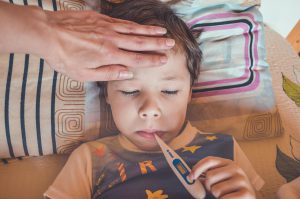If your child is complaining of aches and pains in their joints, you might just write them off as growing pains. But you should be aware that consistent joint pain in children can actually be a condition called juvenile arthritis, which is a chronic disease. Nearly 300,000 children under the age of 18 are affected by juvenile arthritis in the U.S., so the next time your child complains of joint pain, consider the fact that it could be one of the types of this condition. It’s important to know the symptoms so you can catch it and treat it early on.
What Is Juvenile Arthritis?

Juvenile arthritis is an inflammatory disease in which the body’s immune system attacks healthy cells and tissues. Arthritis causes persistent joint inflammation; oftentimes it’s mild and does not progress to a more severe joint disease or deformities, but if left untreated it can cause serious joint and tissue damage. Not only that, but arthritis can cause problems with bone development and growth.
This condition is idiopathic, which means that there is no exact known cause for it, but researchers believe that it might be related to genetics, certain infections, or environmental triggers.
Different Types of Juvenile Arthritis
There are several types of juvenile arthritis. It’s normally classified based on what symptoms the child presents with, the number of joints that are affected, and the presence of markers in the blood when a blood test is performed. The different types of juvenile arthritis include:
- Systemic arthritis– Also called Still’s disease, this type of arthritis can infect the entire body. It usually causes a high fever and rash on the arms and legs, and can affect internal organs such as the heart, spleen, and lymph nodes.
- Oligoarthritis– Also called pauciarticular juvenile, this type of arthritis is often outgrown by adulthood. About 50% of children with juvenile arthritis have the oligoarticular type. It affects girls more often than it does boys, with girls younger than 8 years of age most likely to develop it.
- Polyarthritis– Also called polyarticular juvenile idiopathic arthritis (pJIA), this type affects 5 or more joints in the first 6 months of having the disease. It can affect the joints in the jaw and neck, as well as in the hands and feet. This type is also more common in girls than in boys.
- Enthesitis-related arthritis– This type of arthritis affects the hips, knees, ankles, eyes, and any places where tendons are attached to bones. This type of arthritis occurs mainly in boys who are older than 8 years.
- Psoriatic arthritis– This type of arthritis causes both arthritis and the skin disorder psoriasis.
Symptoms
Juvenile arthritis will affect all children differently, but some symptoms to look for include:
- Joint stiffness
- Pain, swelling, and tenderness in the joints
- Persistent fever
- Rash
- Weight loss
- Limping
- Fatigue
- Irritability
- Blurred vision
- Redness of the eyes or eye pain
Treatment
The best way to beat juvenile arthritis is to catch it early on and get treatment as quickly as possible. To diagnose it, your child’s doctor will order blood tests, review your child’s medical history, and might even request x-rays to look for injuries, to rule out other conditions.
If there are signs that your child has juvenile arthritis, a treatment plan to help control inflammation, relieve pain, and prevent any joint damage will be created. Treatment can include exercise, as well as medications that can treat pain and swelling, including:
- Nonsteroidal anti-inflammatory drugs – You can often find these over the counter; they include drugs like ibuprofen and Naproxen.
- Slow-acting antirheumatic drugs – These drugs treat pain and swelling over time, and can take several weeks to work.
- Corticosteroids – These are usually prescribed as oral medication. Steroids are often avoided in children if possible, though, because they can have side effects including poor growth and weight gain.
Finding Health Insurance Coverage
One of the most important factors in getting the help you need for your child’s arthritis is your health insurance plan. Before choosing a plan, make sure you understand what coverage it offers, and make sure it will cover evaluation and treatment for juvenile arthritis.
We offer a wide range of health insurance plans from top-rated insurance companies in every state. And because we work with so many companies, and can see all of the plans available in your area, we can find you a plan that saves you a lot of money – even hundreds of dollars – even if you don’t qualify for a subsidy. There is no obligation, or hassle, just free quotes on all available plans in your area. To get free instant quotes, simply enter your zip code in the bar above, or to speak to a local agent, call 888-350-1890.
